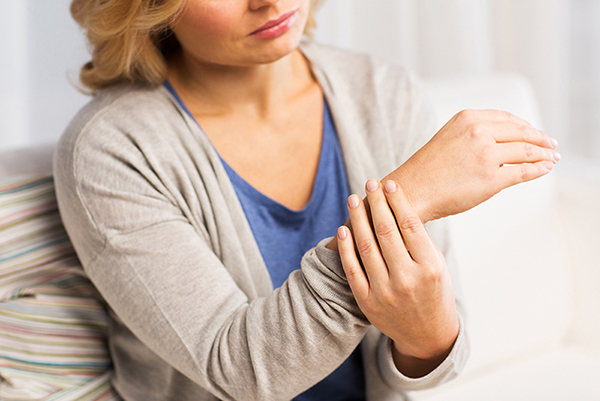This article is reposted with permission and was originally published online as part of USA Today’s Media Planet “Bone & Joint Wellness” campaign within their most recent edition of Personal Health.

Over half of all women and a quarter of men will break a bone in their lifetime because of osteoporosis. Whether you have the disease and are looking for advice on avoiding falls and debilitating breaks, or want to do what you can now to avoid ever getting the condition, Claire Gill, CEO of the National Osteoporosis Foundation (NOF), has advice for you.

What exercises are best for older people that will help them maintain bone health?
Exercise is important for maintaining strong bones at every age to help prevent and manage osteoporosis. It also aids in increasing muscle strength, coordination, and balance, which is directly related to averting falls and fractures. It is critical, however, to check with your healthcare provider before beginning any new exercise regimen.
There are so many bone-building exercises that will improve balance, posture, and how well you function in daily activities. Weight-bearing and resistance exercises are the best for your bones. Weight-bearing exercises force you to work against gravity.
Some high-impact, weight-bearing exercises include dancing, high-impact aerobics, and jogging or running. If you cannot do high-impact, weight-bearing exercises, consider these safe, low-impact alternatives:
- Using elliptical training machines
- Doing low-impact aerobics
- Walking briskly on a treadmill or outdoors
Muscle-strengthening exercises are also important. These include activities that when you move your body, there is weight or some other resistance against gravity. Some of the best exercises in this category include lifting weights, using elastic exercise bands, and doing exercises where you lift your own body weight.
Learn more via NOF’s vast inventory of exercise-focused resources including tip sheets and videos.
Serious fractures can lead to countless medical issues over time. What is the best way to avoid a fracture, especially for seniors?
Studies indicate that half of all women over the age of 50 and a quarter of men will break a bonein their lifetime due to osteoporosis. While these statistics are alarming, there are simple steps older adults can take to help prevent a fracture.
Broken bones of the spine are common in people with osteoporosis and often go unnoticed until more serious problems occur. Learn how to recognize the signs and symptoms of spine fractures and take action to prevent these fractures from occurring in the first place by reading NOF’s Protecting Your Fragile Spine.
NOF has a comprehensive listing of both outdoor and indoor safety tips to help prevent a potentially dangerous accident. Here is a sample of those tips:
When out and about:
- Use a shoulder bag, fanny pack, backpack, or purse to leave your hands free.
- Stop at curbs and check the height before stepping up or down. Be careful at curbs that have been cut away to allow access for bikes or wheelchairs. The incline may lead to a fall.
Make your home fall-proof:
- Place items you use most often in spots that are easy to reach. This keeps you from having to do a lot of bending and stooping.
- Visit https://www.bonehealthandosteoporosis.org/patients/fracturesfall-prevention/ for additional information on preventing falls on floors and stairs, and in the kitchen, bedroom, and bathroom.
Check out NOF’s handy checklist of 25 ways to prevent falls.
With issues related to the COVID-19 pandemic, what are your recommendations for getting exercise and proper amounts of vitamin D?
Millions of Americans have had to rethink how to maintain our daily routines during the COVID-19 pandemic. With exercise being such a critical component to good health – especially for our bones – exploring alternatives to exercise regimens has compelled us to think creatively.
With the approval of your healthcare provider, consider joining osteoporosis-appropriate exercise classes via Zoom. You may want to also practice Pilates or yoga. NOF’s Pilates and yogaflyers share basic visuals for which poses to embrace and which to avoid.
Vitamin D is found in a variety of foods like wild-caught mackerel, salmon, and tuna. It is also added to milk and other dairy products, orange juice, soymilk, and fortified cereals. Additionally, getting outdoors in the summer sunshine – while practicing social distancing – is an excellent way to get vitamin D.
Our bodies need vitamin D to absorb calcium, and it also plays an important role in bone growth and bone healing. Spending time in the sun can provide you with the proper daily dose of this much-needed vitamin, but you’ll have to do it without sunscreen to be able to absorb the vitamin D.
A safer alternative is to take a vitamin D supplement. Discuss this possibility with your healthcare provider.
What can I do right now to prevent osteoporosis?
Across the board, there needs to be a much greater awareness and understanding of this chronic, debilitating disease. Good habits that will help protect your bone health begin in childhood and adolescence.
We reach “peak bone mass” – the strongest and most dense bone we will have – in our early 20s. This means that proper nutrition, including adequate amounts of calcium and vitamin D, as well as weight-bearing and muscle-strengthening exercises, are essential when we’re young.
These same factors will also help keep our bones strong as we age. Establishing and maintaining a healthy diet and exercise routine is essential at every stage of life. It’s never too late to start. There is no time like the present to take action to help prevent osteoporosis.